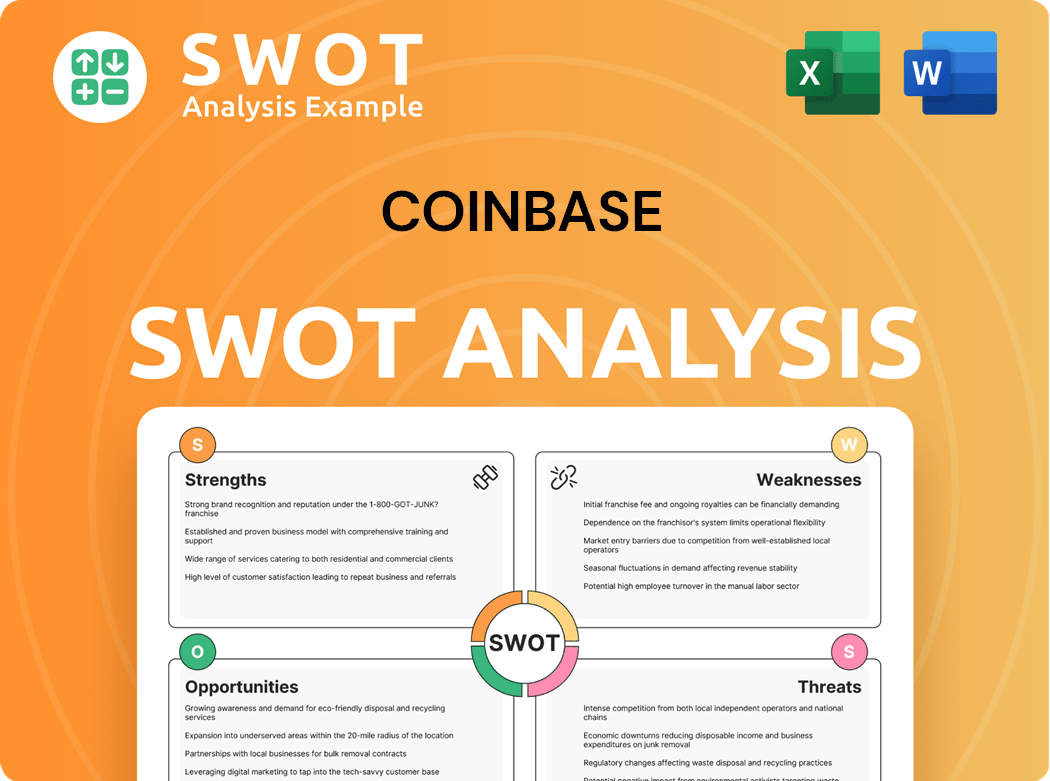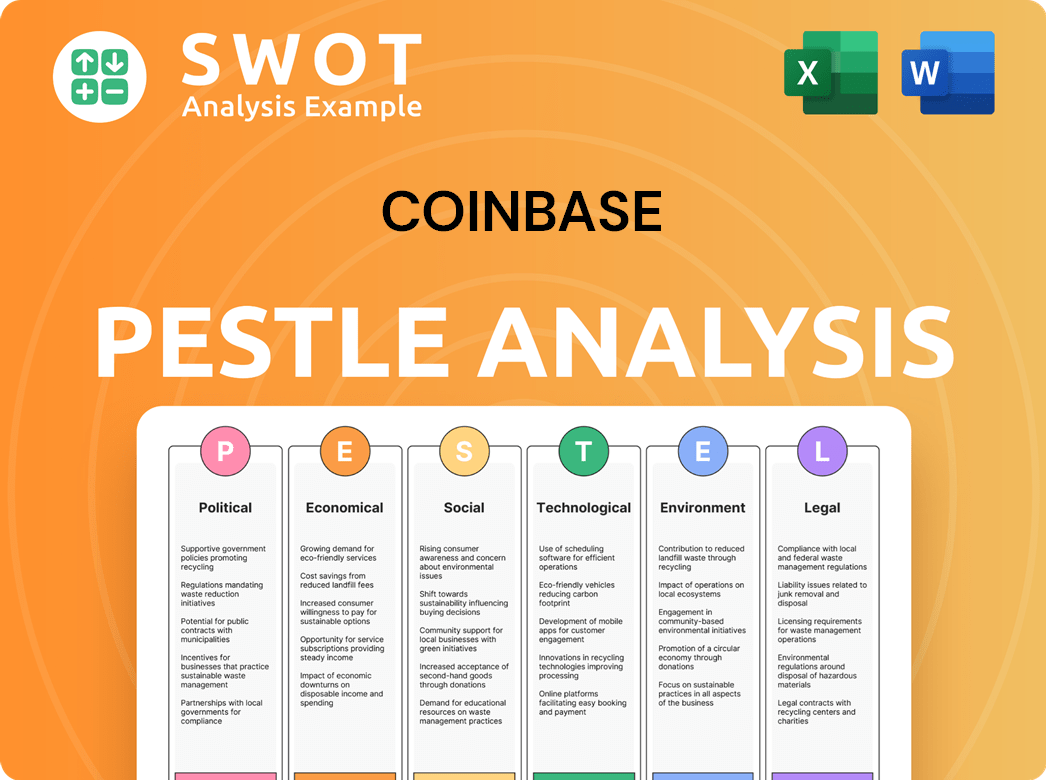Coinbase Bundle
Who Really Owns Coinbase?
Understanding the Coinbase SWOT Analysis can be greatly enhanced by knowing who steers the ship. Coinbase, a titan in the crypto world, has seen its ownership evolve dramatically since its 2012 inception. From its humble beginnings to becoming a publicly traded company, the story of who owns Coinbase is a crucial piece of the puzzle for anyone invested in the digital asset space.

The Coinbase company's ownership structure is more than just a list of shareholders; it's a reflection of its strategic direction and future potential. Examining the influence of Coinbase executives, the role of early Coinbase investors, and the distribution of Coinbase stock provides critical insights. This exploration will dissect the intricacies of Coinbase ownership, offering a comprehensive view of who controls this influential player in the cryptocurrency market and its impact on the global crypto economy.
Who Founded Coinbase?
The story of the Coinbase company began in June 2012, with Brian Armstrong and Fred Ehrsam at the helm as co-founders. Armstrong, after a stint as an engineer at Airbnb, developed the initial concept and secured a $150,000 investment through the Y Combinator startup incubator program. Ehrsam, who previously worked at Goldman Sachs, joined Armstrong shortly after, drawn in by Armstrong's posts on Reddit.
The early days saw the founders in significant control of the company. While specific initial equity splits haven't been publicly detailed, it's known that Armstrong, as CEO, held a substantial stake. Ehrsam, who served as the first President of Coinbase, stepped down from his executive role in January 2017 but maintained a presence on the board and retained a considerable ownership percentage.
Early backing played a crucial role in shaping the Coinbase ownership landscape. In May 2013, Fred Wilson from Union Square Ventures led a $5 million Series A investment. This was followed by a $25 million investment in December from Andreessen Horowitz, Union Square Ventures, and Ribbit Capital. These investments were pivotal in the company's early development and ownership structure.
Brian Armstrong and Fred Ehrsam co-founded Coinbase in June 2012.
Series A in May 2013 led by Fred Wilson from Union Square Ventures.
Armstrong, as CEO, held a substantial stake.
Ehrsam remained on the board and retained a notable ownership percentage.
Andreessen Horowitz, Union Square Ventures, and Ribbit Capital invested in December.
Ben Reeves was initially intended to be part of the founding team but parted ways with Armstrong.
Understanding the initial Coinbase ownership structure explained is crucial for grasping the company's trajectory. From its inception, the founders, particularly Brian Armstrong, held significant control. Early investments from prominent venture capital firms helped fuel the company's growth. Fred Ehrsam's continued involvement on the board and his retained ownership stake are also important factors. For more insights, you can read an article about the history of Coinbase.
- Armstrong's vision and Ehrsam's early involvement were critical.
- Early investments provided the financial backing for expansion.
- The founders' stakes and the early investor landscape set the stage.
- The initial public offering (IPO) further reshaped the Coinbase ownership, introducing a broader base of shareholders.
Coinbase SWOT Analysis
- Complete SWOT Breakdown
- Fully Customizable
- Editable in Excel & Word
- Professional Formatting
- Investor-Ready Format

How Has Coinbase’s Ownership Changed Over Time?
The evolution of Coinbase's ownership structure is marked by its transition from a private startup to a publicly traded company. This shift occurred on April 14, 2021, when Coinbase Global, Inc. went public through a direct listing on the Nasdaq under the ticker symbol 'COIN'. This process allowed existing shareholders to sell their shares directly to the public, bypassing a traditional initial public offering (IPO) and enabling early investors and employees to liquidate their holdings.
The direct listing was a pivotal moment, valuing the company initially at approximately $47 billion. The stock opened at a reference price of $250 per share and closed its first day at $328.28, resulting in a market capitalization of $85.78 billion. This event significantly altered the landscape of Coinbase ownership, introducing a diverse group of institutional and retail investors into the shareholder base and changing the dynamics of Coinbase company.
| Key Event | Date | Impact on Ownership |
|---|---|---|
| Direct Listing on Nasdaq | April 14, 2021 | Transitioned from private to public; allowed existing shareholders to sell shares to the public. |
| Initial Valuation | April 14, 2021 | Estimated initial value of $47 billion; market capitalization reached $85.78 billion on the first day of trading. |
| Ongoing Ownership Structure | As of Recent Data | A mix of institutional, retail, and individual investors; significant holdings by founders and early investors. |
As of recent data, Coinbase ownership is primarily composed of institutional investors, holding about 49.21% of the stock. Vanguard Group is a major institutional holder, with Vanguard Index Funds holding 7.89% and Vanguard owning 8.70% of the shares. Brian Armstrong, the CEO and co-founder, remains the largest overall stockholder, owning approximately 19% of Coinbase's shares and holding 14.56% of the company's shares as of 2025-02-14. Fred Ehrsam, another co-founder, and Marc Andreessen, a board member, also hold significant stakes, influencing company strategy. The concentration of ownership among founders and early investors, along with the dual-class share structure, gives them considerable control over the company's direction.
Coinbase's ownership structure is a blend of institutional and individual investors, shaped by its direct listing in 2021.
- Institutional investors collectively own a substantial portion of the company's stock.
- Brian Armstrong, the CEO, is the largest individual shareholder.
- Founders and early investors have significant influence due to their substantial holdings.
- The dual-class share structure gives considerable control to founders.
Coinbase PESTLE Analysis
- Covers All 6 PESTLE Categories
- No Research Needed – Save Hours of Work
- Built by Experts, Trusted by Consultants
- Instant Download, Ready to Use
- 100% Editable, Fully Customizable

Who Sits on Coinbase’s Board?
Understanding the Coinbase ownership structure reveals a significant concentration of power. The company utilizes a dual-class share structure, common among tech firms. This structure involves Class A common stock, available to the public, granting one vote per share, and Class B common stock, held primarily by insiders, granting 20 votes per share. This design significantly concentrates voting control with founders and early investors, shaping the direction of the Coinbase company.
At the time of the direct listing, holders of Class B common stock held approximately 99.2% of the total voting power. Specifically, directors, executive officers, and 5% stockholders, along with their affiliates, controlled about 60.5% of the voting power. This concentration allows insiders to direct the company and manage key decisions, impacting the influence of Coinbase investors and the broader market. For more insights into the company's strategic growth, consider reading about the Growth Strategy of Coinbase.
| Board Member | Role | Notes |
|---|---|---|
| Brian Armstrong | CEO and Chairman | Also a founder. |
| Fred Ehrsam | Board Member | Co-founder |
| Gokul Rajaram | Board Member | Joined August 2020 |
| Christa Davies | Board Member | CFO of Aon plc, Audit Committee |
| Paul Clement | Board Member | Former U.S. Solicitor General, Audit Committee |
| Chris Lehane | Board Member | VP of Global Affairs, OpenAI |
The current board of directors plays a vital role in the governance of the Coinbase company. As of July 2024, the board expanded to ten members. New additions include Christa Davies, Paul Clement, and Chris Lehane, who will serve until the 2025 annual meeting. Coinbase executives, including the CEO and co-founders, hold key positions, influencing the company's strategic direction. The board composition ensures that the founders' vision and the interests of early investors continue to guide the company. This structure highlights who controls Coinbase and the influence of major shareholders.
The dual-class share structure concentrates voting power with insiders.
- Insiders control a significant percentage of voting rights.
- The board includes founders and key figures.
- This structure influences strategic decisions and company direction.
- Understanding this structure is crucial for assessing Coinbase stock.
Coinbase Business Model Canvas
- Complete 9-Block Business Model Canvas
- Effortlessly Communicate Your Business Strategy
- Investor-Ready BMC Format
- 100% Editable and Customizable
- Clear and Structured Layout

What Recent Changes Have Shaped Coinbase’s Ownership Landscape?
In the past few years, the ownership structure of the Coinbase company has seen significant developments. The board authorized a share repurchase program in October 2024, with plans to buy back up to $1 billion of Class A common stock, reflecting a strategic move to manage capital and potentially boost shareholder value. However, as of February 13, 2025, no shares had been repurchased under this program, indicating a cautious approach to market conditions.
Individual insider trading activity presents a mixed picture. While some executives have sold shares, they have also shown interest in buying back. Brian Armstrong, for example, has sold shares to fund other ventures. Simultaneously, Fred Ehrsam has actively traded the company stock through linked trusts and funds. These transactions highlight the dynamic nature of insider ownership and the ongoing adjustments within the company's leadership and financial strategies.
| Ownership Aspect | Details | Data |
|---|---|---|
| Institutional Ownership | Percentage of stock held by institutional investors | Approximately 49.21% (Recent Data) |
| Share Repurchase Program | Authorized amount for share buyback | Up to $1 billion |
| Insider Sales | Brian Armstrong's share sales | Approximately 790,000 shares sold (Nov 2022-Nov 2023) |
Industry trends show that institutional investors hold a significant portion of the company's stock, with approximately 49.21% of the shares held by institutional investors as of recent data. The company's dual-class share structure, which provides insiders with outsized voting power, is a common feature in U.S. tech IPOs. The company has also been expanding its board, adding new directors in July 2024, including an executive from OpenAI, a former U.S. Solicitor General, and the CFO of Aon, indicating a move to strengthen governance and strategic oversight as the company seeks to increase its influence in the crypto regulatory landscape. In January 2025, the company announced additions to its advisory council, including former Federal Reserve Bank of New York president William Dudley and a co-manager of Donald Trump's 2024 campaign, reflecting efforts to navigate the political and regulatory environment.
The company's ownership structure is influenced by both institutional and individual investors. The dual-class share structure ensures founders maintain significant control. Recent share repurchases and insider trading reflect ongoing adjustments in ownership.
Brian Armstrong, as the CEO, plays a central role, with other key figures also involved. Fred Ehrsam's trading activities are another important aspect. The board of directors includes new members, shaping the company's governance.
Institutional investors hold a significant percentage of the company's stock. The company's financial backers and initial investors have shaped its trajectory. The company's IPO marked a key moment for investors.
Coinbase stock has seen fluctuations, influenced by market conditions and company performance. The share repurchase program aims to impact the stock's value. Insider trading activity also affects stock dynamics.
Coinbase Porter's Five Forces Analysis
- Covers All 5 Competitive Forces in Detail
- Structured for Consultants, Students, and Founders
- 100% Editable in Microsoft Word & Excel
- Instant Digital Download – Use Immediately
- Compatible with Mac & PC – Fully Unlocked

Related Blogs
- What are Mission Vision & Core Values of Coinbase Company?
- What is Competitive Landscape of Coinbase Company?
- What is Growth Strategy and Future Prospects of Coinbase Company?
- How Does Coinbase Company Work?
- What is Sales and Marketing Strategy of Coinbase Company?
- What is Brief History of Coinbase Company?
- What is Customer Demographics and Target Market of Coinbase Company?
Disclaimer
All information, articles, and product details provided on this website are for general informational and educational purposes only. We do not claim any ownership over, nor do we intend to infringe upon, any trademarks, copyrights, logos, brand names, or other intellectual property mentioned or depicted on this site. Such intellectual property remains the property of its respective owners, and any references here are made solely for identification or informational purposes, without implying any affiliation, endorsement, or partnership.
We make no representations or warranties, express or implied, regarding the accuracy, completeness, or suitability of any content or products presented. Nothing on this website should be construed as legal, tax, investment, financial, medical, or other professional advice. In addition, no part of this site—including articles or product references—constitutes a solicitation, recommendation, endorsement, advertisement, or offer to buy or sell any securities, franchises, or other financial instruments, particularly in jurisdictions where such activity would be unlawful.
All content is of a general nature and may not address the specific circumstances of any individual or entity. It is not a substitute for professional advice or services. Any actions you take based on the information provided here are strictly at your own risk. You accept full responsibility for any decisions or outcomes arising from your use of this website and agree to release us from any liability in connection with your use of, or reliance upon, the content or products found herein.